Another day, another ambulance ride. Yes, really. Let me preface by saying – Thea is fine now. This is the story of May 13th, 2016, when she wasn’t fine.
Warning: This blog post will talk about poop in some detail. I’ve spent the past week discussing my kid’s poop at greater length than many parents ever do, so I’m pretty much numb to “ick”, but you feel free to move along if these aren’t the droids you’re looking for.
Here’s what happened:
On Friday, May 13th, Luke and Thea were having a perfectly pleasant Daddy-Daughter Friday at home. Thea was healthy and happy, and went down easily for her nap at 10:30. That nap usually lasts three hours but, this time, she woke up screaming at 11:30. Not crying – screaming. Luke dashed upstairs to comfort her, but her screams quickly turned into struggling to breathe. Luke called 911 and an ambulance arrived within minutes (though it felt much longer to him). The paramedics put an oxygen mask on her, loaded her into the ambulance and, after determining that her oxygen levels were dipping into the 70s when they should be at 100%, they turned on the lights and sirens to rush her to the Alberta Children’s Hospital (ACH).
I got a very brief call at work from Luke saying, “Meet us at the Children’s Hospital,” so I grabbed my coat and left the office. When I found them at ACH, Thea was surrounded by a half-dozen medical professionals and she was screaming her head off. She was hooked up to an IV and EKG, and then we were told to leave the room while her chest was x-rayed. That was, hands down, the hardest part of the entire ordeal because it was the only time we both had to leave her side. Listening to those cries was indescribably awful.
We were back at her side as soon as the pictures were taken, and then I was allowed to climb onto the examination table and the nurses laid her on my chest while various tests continued. She started to calm down a little bit once she was in my arms. The chest x-rays showed a massive air bubble occupying pretty much her whole stomach. I’ve included a picture of it here. For context, scroll down to the second x-ray picture on this post. See that small, dark circle in the upper right part of her chest? That’s a normal amount of air. The gigantic oblong bubble across her body in this first x-ray is the air bubble that was in her belly when we arrived at the hospital:
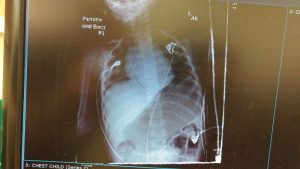
The doctors suspected the air in Thea’s stomach could be putting pressure on her lungs, causing the breathing issues. Through nasogastric (NG) intubation, a tube was stuck through her nose down into her stomach, and a syringe pulled out (to the best of our memories) 15 mL of air. Thea stayed on my chest and sobbed and threw up during the procedure but calmed down remarkably fast once it was over. That was the first of many times over the next few days that she recovered almost instantaneously from highly invasive procedures. She never ceases to amaze us.
As she calmed down, Thea’s stats improved dramatically. Her oxygen levels crept back up to north of 95%, and though her heart rate remained high, that could be somewhat explained by the alarming environment in which she was sitting. She had also developed a fever, but it was being managed by Advil. We spoke with a few surgeons who had been called in to look things over, just in case, and they agreed that their services did not appear to be required, based on her improvements. Big relief.
We moved to a regular examination room in the emergency department and were interviewed by several staff who were trying to figure out what went wrong and how to keep it from happening again. She was admitted and we were moved up to what would be our home for the following two days. Conversations with multiple pediatricians and specialists over the next several hours revealed they were largely flummoxed. When Thea was calm, she seemed entirely healthy, to the point of which it looked like she had no reason to be in a hospital. But, the very second she got upset or began to cry, her oxygen levels would plummet into the 80s, her heart rate would spike to as high as 200 bpm (120-140 was her normal by the time this was all over and we were leaving). It wasn’t that she was holding her breath or anything, these things happened the very second she became agitated, and they took longer than they ought to settle once we had calmed her back down.
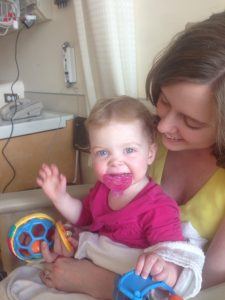
The closest thing to a “key” to this puzzle was found via another set of x-rays, taken around midnight on Saturday morning. Now that the giant air bubble was out of the way, this x-ray revealed that Thea was, quite simply, full of shit. Literally.
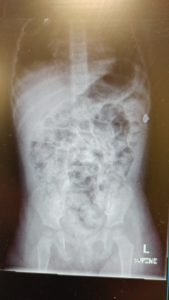
See allllllll that lumpy, circular stuff? That’s poop. Yup.
I feel the need to back up a bit at this point to say – Thea’s never been a “frequent” pooper. From 0-6 months, she pooped every 3-4 days. Once she started solid foods at six months, she pooped every 6-10 days for the subsequent six months. From one-year-old until now, she generally pooped every one or two days. In the lead-up to this event, she had been having one small poop per day, including Friday morning.
Trust me, we worried and we took her to the doctor on multiple occasions but, we were always reassured that this was simply her “normal”, and as long as she wasn’t showing signs that she was in pain, we needn’t worry. I’m in no way saying that advice was wrong, I’m just trying to explain how we could possibly not notice that our daughter was so badly constipated that she stopped breathing.
…Because that’s what happened. As best as anyone can tell, Thea became so constipated that air built up in her stomach and her digestive system was so inflated with poop and air that it put pressure on her lungs and made it difficult for her to breathe. Removing the air via an NG relieved some of the pressure, but tightening muscles when she cried was still causing problems because her belly was chalk-full of poop.
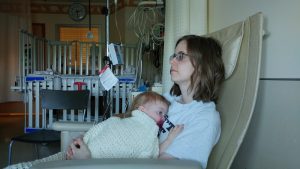
Once the pediatricians saw the problem, the course of action was obvious – Thea was given an enema on Saturday afternoon. That cleared out much (but not all) of the poop, and suddenly her vitals were stable again, even when she cried. Let me say – the doctors were still mildly fascinated with it all. Poop-induced respiratory distress was not something (as far as we were told) they had ever come across before, but it was the only logical conclusion, based on her symptoms and the success of the “treatment”.
After the enema, it was largely a matter of monitoring her for another 18 hours or so to ensure there were no further incidents. Thea was allowed to eat solid food for the first time in nearly 36 hours, and her energy-level went way up after that. It actually became more difficult at that point for Luke and me to manage her because she started fidgeting and asking to walk around (a difficult thing to do when you have five wires connecting your body to various stationary machines).
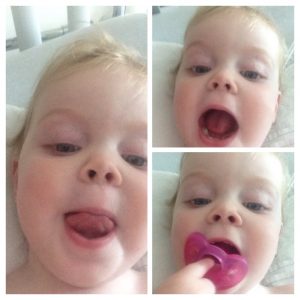
Thankfully, we were on our way home shortly after lunch on Sunday. Before we left, we were given a go-forward plan that involves a daily laxative in the form of PEG 3350. PEG is a very safe powder that makes her poop retain water, so that it is soft and passes easily. She will likely be taking this for several months because her bowels will have been stretched out by the constipation and they need help until they can tighten back up. The good news is they will tighten back up; this is 100% reversible and using PEG will have no long-term effects. (Spoiler Alert – as in, reading the next sentence may spoil your appetite – I discovered the PEG was “working” the day after we got home, when Thea told me she pooped during supper and, when attempting to confirm her statement, I accidentally stuck my fingers in her FULL TO THE BRIM diaper. I may never stop washing my hand.)
So that’s the story. Thea is fine. In fact, once we got home, you’d never have known she’d ever been in the hospital, save for the Mickey Mouse bandaid over her IV site (she was very sad to lose that bandaid a few days later). Luke and I will take much longer to recover. We no longer gush over her “big belly” after a large meal but, instead, quietly wonder if she’s pooping enough. Our conversations over the past week have been approximately 40% “poop” and 60% “other topics”. I’m sure we will gradually calm down, it will just take time.
Now comes the Thank You part of this post – Thea received top-notch care from ACH. In the time we were there, she received bloodwork, an IV, ECG, EKG, NG, an echo (ultrasond of the heart), three sets of chest x-rays, an urinalysis test, and an enema. We interacted with countless doctors, nurses, and support staff, every single one of whom was kind, helpful, and professional. We left feeling confident that we had the answers that we needed and that Thea was on the mend. I will be eternally grateful to live in a community with access to a dedicated Children’s Hospital.
The next Thank You is for our family. Luke’s Mom arrived within an hour of his phone call. By pure coincidence, my Mum was flying in for a visit that evening, and she arrived at the hospital with my Brother and Sis-in-Law Friday night. Over the course of the weekend, every single member of our immediate family gave us support, whether in person by watching over Thea while Luke and I took a break to eat in the cafeteria, or driving to our house in Chestermere to feed Gemini, or calling, texting, and emailing with comforting words, or showing up with pizza and ice cream cake to celebrate when we made it home. We love you all.
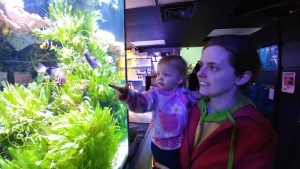
PS: Oh, I almost forgot – One of the most confusing symptoms for the pediatricians had been her fever – that just didn’t fit in with everything else. The best suggestion was that it might be an early sign of a virus that would manifest over the next week. Sure enough – the day after we got home from the hospital, Thea developed a cold. She also had an ear infection five days later, but we don’t think that was necessarily related, since her ears were examined several times in the hospital. (When it rains, it pours.)